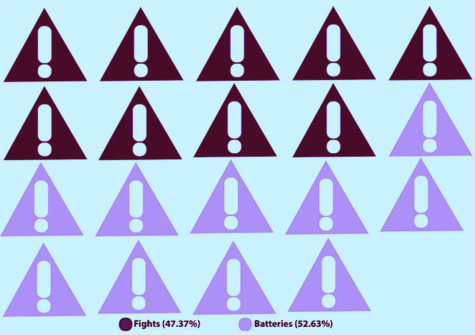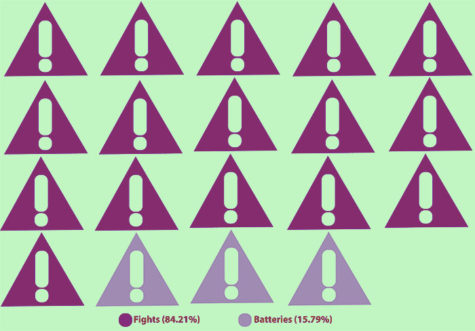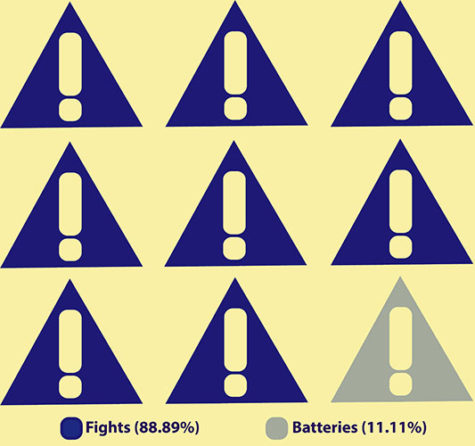Maintaining law and order
January 29, 2019
Maintaining law and order:
Fights are a part of high school, and when a fight breaks out, security officers jump in to intervene. While this occurs, other security personnel will get on the radio and notify the deans, the school resource Officer Kevin Chapin, and extra security personnel that are free. Those who are fighting are separated when this occurs, and the deans take the students down to their offices.

Fights have been an issue over many years. In the 2016-17 school-year, there were 19 altercations.
Officer Dan Niemann explained the importance of defusing the situation and the next steps necessary for handling fights.
“We get everybody down to the dean’s’ office, and we try to get to the root of the problem, and then we try to come up with a solution to the problem,” Niemann said.
The deans and administrators take care of the situation at hand and handle the consequences. Meanwhile, they notify the Downers Grove Police Department, whose school resource officer is Kevin Chapin. The police take a note of the incident, get the names of those involved and oversee the review process of the fight.
“If there’s a fight, we all share radios. So there’s typically communication whether it’s a student supervisor, security officer, myself, a dean or staff [that] gets notified. We’re going to review videos and stuff of that nature,” Chapin said.
Consequences follow fights and the school and DGPD determine the consequences after reviewing videos from the cameras and interviewing students. The consequences come in different forms, as the deans primarily handle in-school punishments while the DGPD solicit their own form of punishment depending on the severity of the fight.
However, the topic of self-defense comes into question when determining the harshness of the fight. When reviewing the footage of the fight, administrators and police decide the proper punishments for students. They also must determine if a student is in self-defense, and when a student chooses to engage and go “on the offensive”, as punishments may vary depending on how they determine a student was engaged.

In the 2017-18 school-year, there were 19 altercations with only three being considered a battery.
“In school, the way it works is yes we can have a person initiate a fight, they’re still the offender. We can then have the individual who’s actually defending themself but then engages in the fight receive consequences for engaging. That’s what’s called disorderly conduct,” Niemann said.
In order to ensure that students do not get punishments that can put a negative mark on their resume, security guard Cahill offered an explanation for preventing fights before they even start.
“[We should have] more staff members in the hallways, as we’ve roughly got 2,800 students. [They’re] in the cafeteria, and the hallways are pretty full, and it can get pretty chaotic,” Cahill said.
Chapin explicitly stated that students who get involved in a fight will receive consequences and that those who are attacked should do whatever they could to avoid getting involved.
“It’s important that we’re very clear-cut [that] if two people are engaged in a fight, there have to be consequences for both. Very rarely have I seen it where a student is sitting at a table and it’s a random attack. If someone’s being attacked and I’m watching the video and they’re clearly just pushing and not hitting, or someone aggressively gets in your face, that’s when you turn around,” Chapin said.
Students who initially are attacked then retaliate will likely receive consequences as a result of reengaging the attacker, therefore prolonging the fight. Punishments follow swiftly, as Niemann and Chapin corroborated.

So far there have been nine altercations this year.
“A battery offender is the person who makes contact in an insulting or provoking nature. That person who initiates the fight may get more severe consequences because battery is a more severe crime than disorderly conduct. However, yes, the student does get in trouble for engaging in a disturbance that occurred in the school,” Niemann said.
“It can either be handled only by the school, or it could be handled with me, and we could have a village ordinance charge. [Anything] that’s a little excessive [such as kicking and punching], that’s when the charge is a disorderly conduct charge, a village ordinance, and the subsection under that is fighting. So it’s engaging in a fight,” Chapin said.